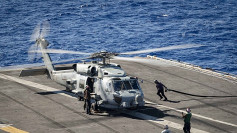The world's largest iceberg is on a collision course with the British Overseas Territory of South Georgia.
Scientists say if the iceberg ends up near the island it could cause a catastrophic disturbance in the wildlife haven's ecosystem.
The iceberg, which is roughly the same size as the South Atlantic Island of South Georgia, is close to the island and could become stuck. If that happens, animals such as penguins and seals in the area could be threatened.
Wildlife experts explained that the iceberg could end up blocking normal foraging routes. Animals living on the seafloor could also be crushed by the massive iceberg, causing an ecological disturbance that could take a very long time to reverse.
"Ecosystems can and will bounce back of course, but there's a danger here that if this iceberg gets stuck, it could be there for 10 years... and that would make a very big difference, not just to the ecosystem of South Georgia but its economy as well," the British Antarctic Survey (BAS) said.
Scientists have been tracking A68a's movement since it broke off from Antarctica in 2017. It has since been riding up the "iceberg alley," a strong current that has sent numerous icebergs near the shallows of the continental shelf near the island.
The iceberg, which looks like a hand pointing a finger, is roughly 4,200 square kilometers in size with a weight estimated to be in the hundreds of billions of tons. A68a is relatively thin compared to other icebergs, with a submerged depth of around 200 meters. Its lack of thickness means that it could end up being stuck closer to South Georgia's coast than any other icebergs.
The BAS said that such a huge iceberg ending up being stuck near the coast could result in the deaths of hundreds of penguins and seal pups as it could block land-based predators from their normal foraging areas. In 2004, iceberg A38 ended up stuck near the South Georgia coast. Scientists later found countless dead penguin chicks and seal pups near local beaches.
"When you're talking about penguins and seals during the period that's really crucial to them - during pup- and chick-rearing - the actual distance they have to travel to find food really matters. If they have to do a big detour, it means they're not going to get back to their young in time to prevent them from starving to death in the interim," wildlife experts as BAS explained.
The BAS remote-sensing and mapping specialist, Dr. Peter Fretwell, said that while the iceberg does look like it is heading straight for the island, it could drift away and escape capture. He pointed out that anything is possible at this point as currents around the area remain unpredictable.






